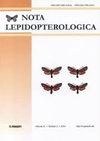The中欧北部低地凸起沼泽中泥沼专业蝴蝶的分布格局
IF 0.7
4区 农林科学
Q4 ENTOMOLOGY
引用次数: 0
摘要
。凸起的沼泽是极端的、地带性的生态系统,具有独特的水文平衡、小气候条件和特定的动植物群。近年来,这些生态系统因其在全球变暖和提供生物多样性避难所方面的重要生态系统作用而日益成为科学界和公众关注的焦点。从生物地理和进化的角度来看,欧洲低地的泥炭沼泽是古避难所,是温带生物群系中北极高山或北方山地昆虫物种的寒冷、土壤岛屿栖息地。我们分析了中欧北部低地105个泥炭沼泽地点,比较了六种蝴蝶的多样性和地理分布模式,它们似乎是嗜湿或嗜湿的沼泽专家。研究结果表明,欧洲低地平均物种数量从东(白俄罗斯北部,约4种)到西(德国北部,约1种)呈递减趋势,物种数量的减少可能主要是由于过去人类活动的影响。个体分布格局表明,德国北部敏感的泥炭沼泽特有物种Colias palaeno和Boloria eunomia的出现几乎完全空白,而东欧泥炭沼泽中这些物种的存在越来越多。与C. palaeno相比,Boloria aquilonaris表现出不同的模式,在所有采样区域连续分布,面对人类对泥炭沼泽的影响,Boloria aquilonaris似乎更能容忍恐蝴蝶。结合近年来的研究结果,我们的研究结果还表明,水蛭(Boloria aquilonaris)和水蛭(Plebejus optilete)可能是泥炭沼泽生态系统恢复成功的目标物种。本文章由计算机程序翻译,如有差异,请以英文原文为准。
The distribution pattern of mire specialist butterflies in raised bogs of the northern lowlands of Central Europe
.
Raised bogs are extreme and azonal ecosystems with a characteristic hydrological balance, microclimatic conditions and a specific flora and fauna. Recently, these ecosystems have increasingly become the focus of scientific and general attention because of their important ecosystem roles in the face of global warming and providing biodiversity refuges. From a biogeographical and evolutionary context, the peat bogs of the European Lowlands serve as palaeorefugia, acting as cold, edaphic island habitats for arcto-alpine or boreo-montane insect species in temperate biomes. Analysing 105 peat bog sites in the northern lowlands of Central Europe, we compare the diversity and geographic distribution pattern of a subset of six butterfly species, which appear to be tyrphobiontic or tyrphophile mire specialists. We demonstrate a decrease in mean species number in the European Lowlands on a gradient from the east (Northern Belarus, about 4 species) to the west (Northern Germany, about 1 species), and suggest that the decreasing species number may be mainly caused by human impact in the past. The individual distribution pattern shows a nearly complete gap in occurrence of the sensitive bog specialist species Colias palaeno and Boloria eunomia in Northern Germany and an increasing presence of those species in peat bogs of eastern Europe. Boloria aquilonaris shows a different pattern, which, in contrast to C. palaeno, is continuously distributed in all sampled regions and seems to be the more tolerant of tyrphobiontic butterflies in the face of human impact on peat bogs. In the light of other recent findings our results also suggest that Boloria aquilonaris and Plebejus optilete may serve as target species reflecting success in ecological restoration of peat bog ecosystems.
求助全文
通过发布文献求助,成功后即可免费获取论文全文。
去求助
来源期刊

Nota Lepidopterologica
Agricultural and Biological Sciences-Insect Science
CiteScore
1.70
自引率
14.30%
发文量
20
审稿时长
14 weeks
期刊介绍:
Nota Lepidopterologica is the scientific, peer-reviewed journal of the Societas Europaea Lepidopterologica (SEL). It publishes original contributions to the study of mainly but not exclusively Palaearctic Lepidoptera, especially on taxonomy, morphology/anatomy, phylogenetics, biogeography, ecology, behaviour, and conservation, but also on any other aspects of lepidopterology.
All articles are published in English, with the possibility of having the summary written in other languages. All submitted manuscripts are subject to peer-review by the leading specialists for the respective topic. The journal is published in open access high-resolution PDF, semantically enriched HTML and machine-readable XML versions.
All papers can be freely copied, downloaded, printed and distributed at no charge. Authors and readers are thus encouraged to post the pdf files of published papers on homepages or elsewhere to expedite distribution. Publication is free for the SEL members and there is no charge for color.
 求助内容:
求助内容: 应助结果提醒方式:
应助结果提醒方式:


